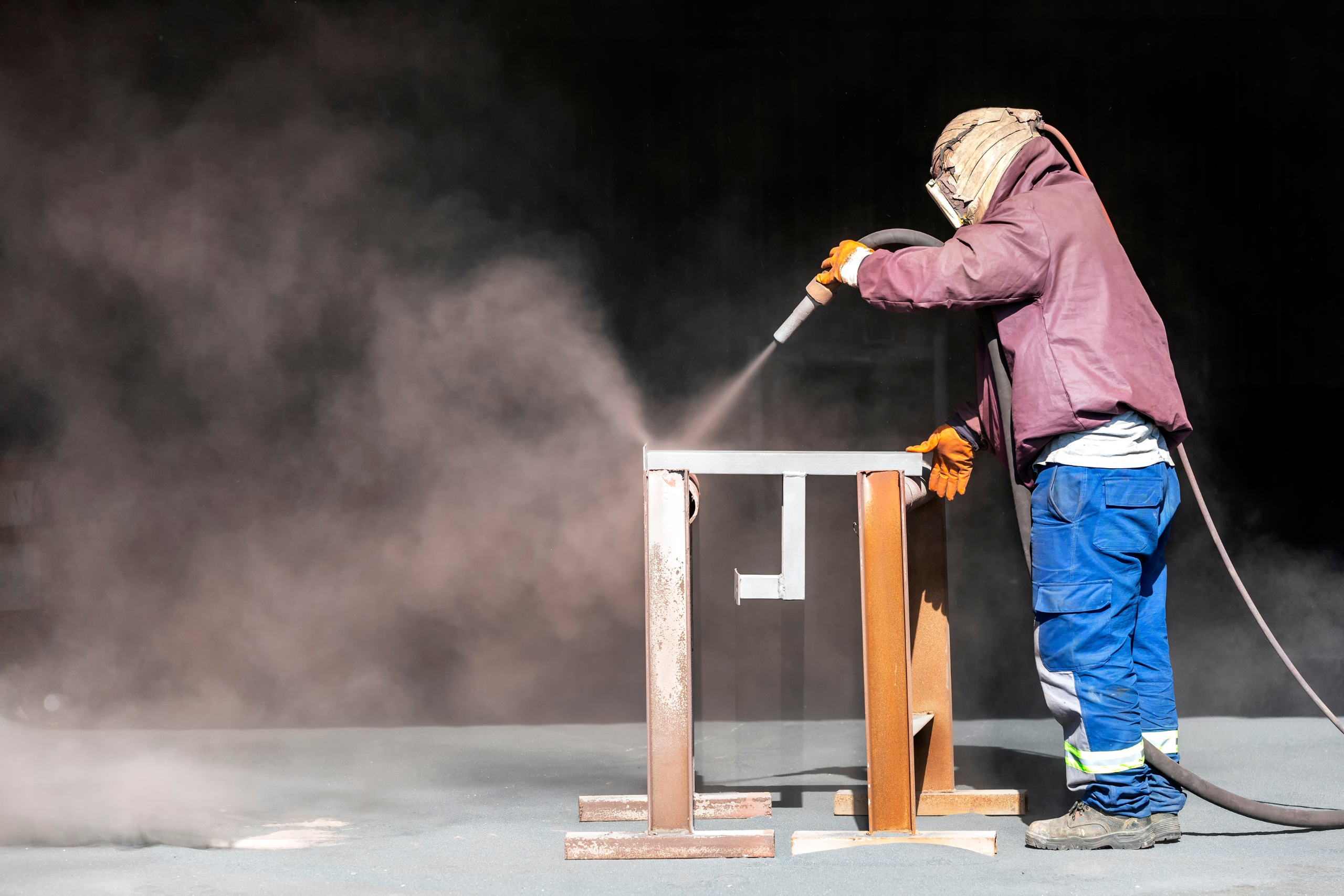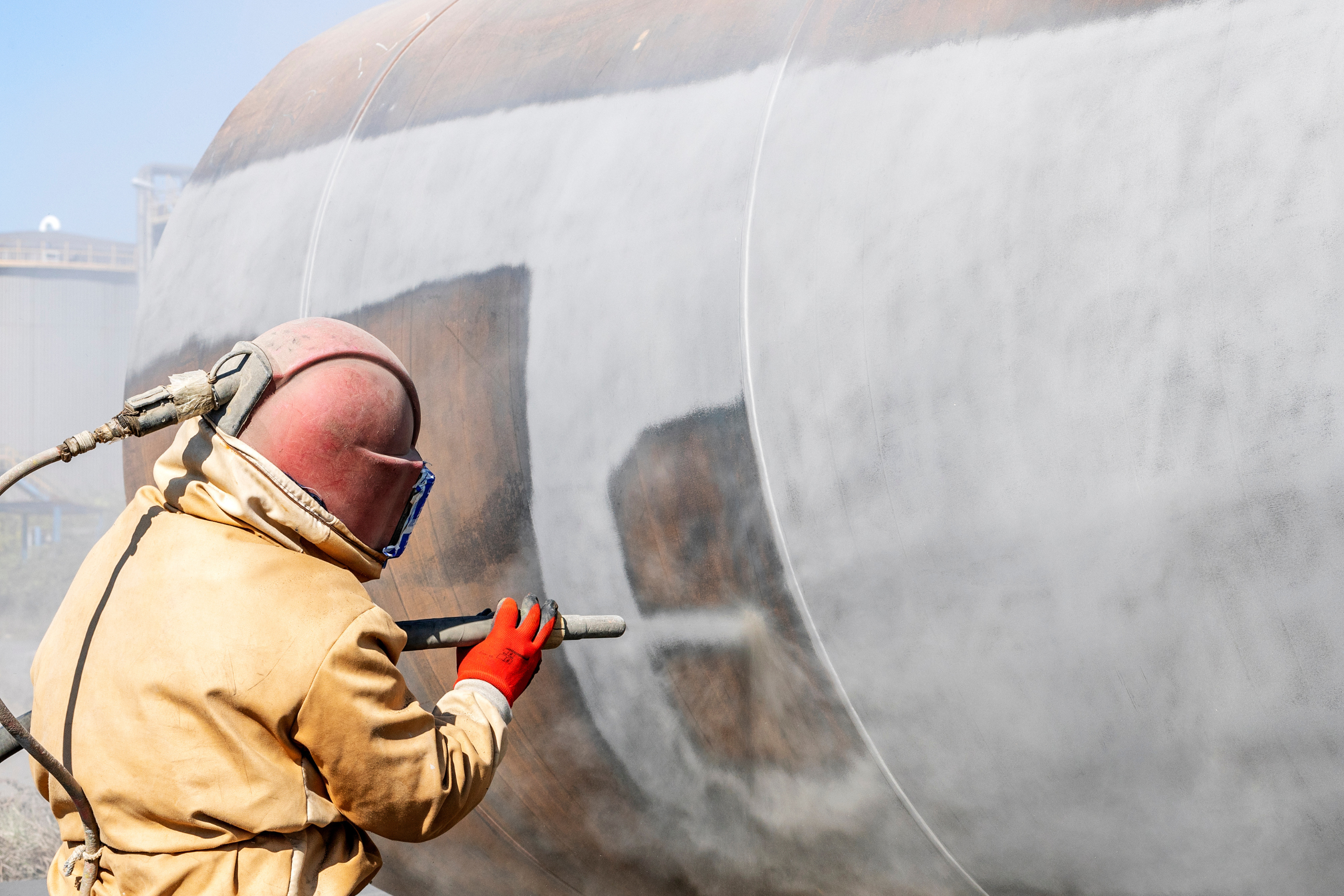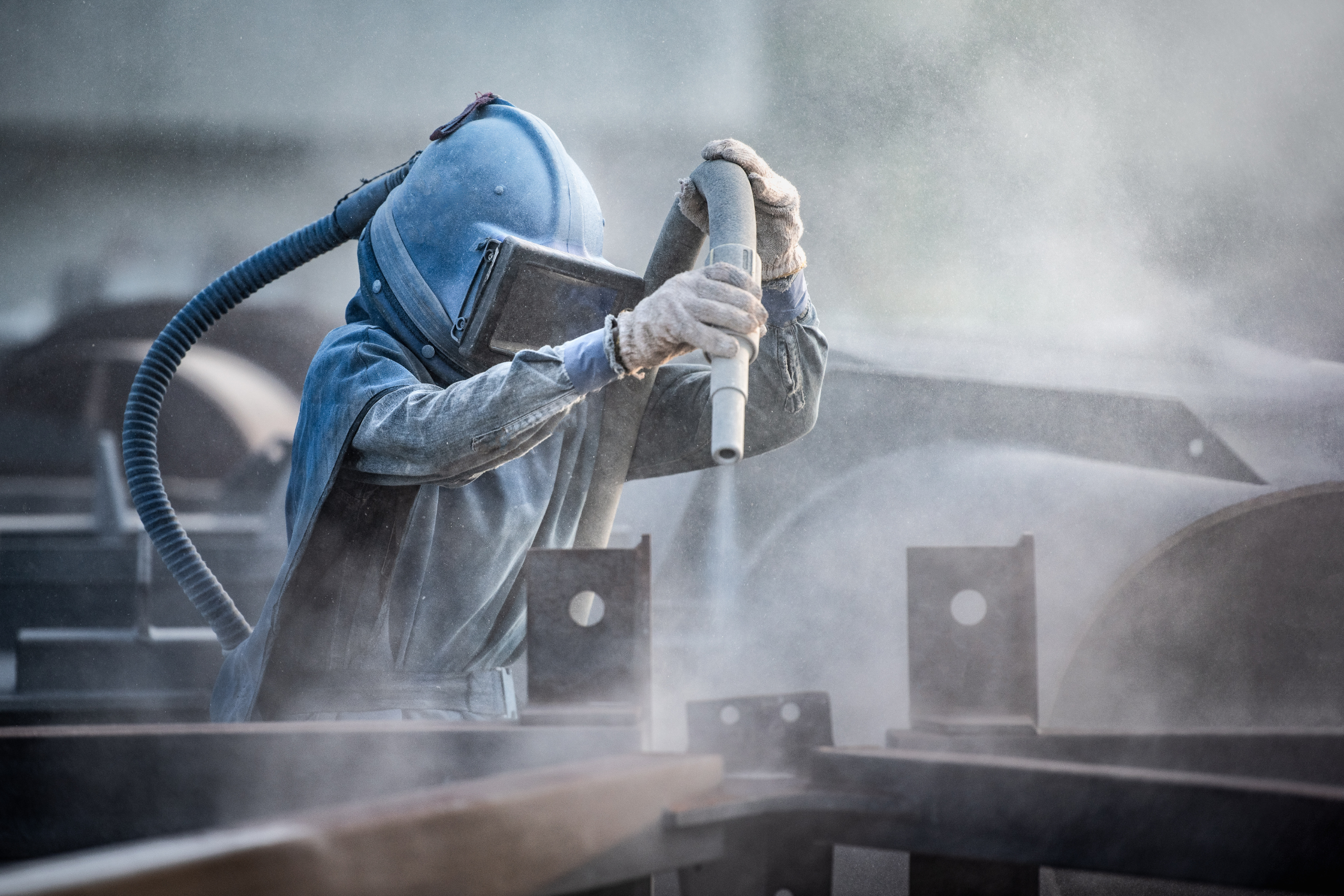Finish Architectural Knowledge Base
What Is Shot Blasting & How Does It Work?

Shot blasting is a widely used surface preparation technique that involves propelling abrasive materials at high speeds to remove contaminants and improve the surface quality of various materials.
This article aims to provide you with a comprehensive understanding of shot blasting and its working principles. By exploring the process, techniques, and applications of shot blasting, we aim to provide you with valuable insights into this surface preparation technique.
What is Shot Blasting and How Does it Work?
Shot blasting is a surface preparation method used to clean, polish, or strengthen materials by forcibly propelling abrasive particles at high speeds. It is a highly effective and efficient technique that has become widely used in various industries.
It is predominantly used on metals and harder materials and is more aggressive compared to other surface treatment methods, such as sandblasting, which is also used on softer materials like wood and glass.
The shot blasting process involves the use of a machine that propels small metallic or non-metallic particles, known as shot, onto the surface of the material being treated. These particles impact the surface at high velocities, removing any contaminants, rust, or old coatings present. The impact of the shot also creates a texture on the surface, resulting in improved adhesion for subsequent coatings or treatments.
The shot blasting machine typically consists of a blast wheel, which is responsible for propelling the shot particles, a containment area to capture and recycle the shot, and a dust collection system to control and remove any airborne particles.

What is Shot Blasting Used For?
Shot blasting is used in various industries for different purposes. One of the main benefits of shot blasting is its ability to remove contaminants and prepare surfaces for coating or painting. Additionally, shot blasting is commonly used for cleaning and restoring surfaces, removing rust and scale, and improving the overall appearance of materials.
What are Some Benefits of Shot Blasting?
Shot blasting is a highly effective surface preparation technique used for various applications. One of the main benefits of shot blasting is that it removes contaminants and unwanted materials from the surface, such as rust, paint, and scale. This process not only cleans the surface but also improves its adhesion properties, making it easier for coatings, paints, or adhesives to bond effectively.
It can be used on Various Materials
Shot blasting can be used on various materials, including metal, concrete, and wood. It is also a versatile method that can be used for different purposes, such as preparing surfaces for painting, removing old coatings, or creating a textured surface for better grip.
It’s Highly Efficient
Shot blasting is a faster and more efficient method compared to traditional surface preparation techniques, saving both time and labour costs.

Applications of Shot Blasting
One of the primary uses of shot blasting is in the preparation of surfaces for industrial painting and coating applications. Shot blasting is an effective and efficient method for removing contaminants, such as rust, scale, and old coatings, from the surface of materials.
By propelling small steel shots at high velocity onto the surface, shot blasting can effectively clean and roughen the surface, creating a suitable profile for paint or coating adhesion. This process ensures that the coating applied to the surface will adhere properly and provide long-lasting protection.
Shot blasting is widely used in industries such as automotive, aerospace, construction, and manufacturing for various purposes, including surface cleaning, deburring, descaling, and improving surface finish. Its versatility and effectiveness make shot blasting a crucial process in many industrial applications.
The Shot Blasting Process Explained
The shot blasting process involves the use of specialised components and equipment to remove surface contaminants and prepare a substrate for further treatment. This includes a blasting machine, abrasive media, and a dust collection system. In a step-by-step guide, the process typically involves loading the machine, adjusting the blast parameters, and directing the high-velocity abrasive media onto the surface to be treated.

Components and Equipment Used in Shot Blasting
During the shot blasting process, various components and equipment are utilised to achieve effective surface preparation. The main component used in shot blasting is the abrasive material, which can be steel shot, grit, or sand. This abrasive material is propelled at high speeds using a blasting machine.
The blasting machine consists of a blast wheel or turbine that generates the force needed to propel the abrasive material. The abrasive material is stored in a hopper and fed into the blast wheel through a control valve. The blast wheel is driven by an electric motor or an engine, providing the necessary power.
The shot blasting process requires a dust collector to remove the dust and debris generated during the blasting operation to ensure a clean working environment. These components work cohesively to effectively remove contaminants and prepare surfaces for further treatment or coating.
Step-by-step Guide to Shot Blasting
The first step of the shot-blasting process is to prepare the surface by removing any contaminants like rust, scale, or paint from the surface being operated on. This can be done using mechanical methods or chemical cleaning agents.
Setting Up the Equipment
Next, the equipment needs to be set up, including the blast cabinet, abrasive material, and air compressor. The operator then adjusts the blasting parameters such as the air pressure and abrasive flow rate to achieve the desired surface finish.
Start the Shot Blasting Process
Once everything is ready, the blasting process can begin. The operator directs the nozzle towards the surface and releases the abrasive material under high pressure, which removes the contaminants and creates a textured finish. Throughout the process, it is essential to wear protective gear and follow safety guidelines to prevent any injuries.
Abrasive Blasting Techniques
Abrasive blasting techniques employ high-pressure streams of abrasive materials to remove surface contaminants. This process is widely used in various industries to clean, prepare, or modify the surface of a material. There are several types of abrasive blasting techniques, each with its own unique application and benefits.
Sandblasting
One common technique is known as sandblasting, where sand particles are propelled at high speed to remove rust, paint, or other coatings from surfaces. Sandblasting is effective for heavy-duty cleaning and surface preparation.
Shot Blasting
Another technique is called shot blasting, which uses small steel balls, known as shot, to remove surface impurities. Shot blasting is often used to prepare surfaces for painting, coating, or bonding by creating a roughened texture that improves adhesion.
Abrasive Blasting
Additionally, there is abrasive blasting using materials such as glass beads, aluminium oxide, or walnut shells. These materials are chosen based on the specific requirements of the surface being treated, such as the desired finish or the need to avoid damaging delicate surfaces.
What are the Differences Between Shot Blasting and Sandblasting?
Shot blasting and sandblasting are two commonly used abrasive blasting techniques, but they have distinct differences. Shot blasting involves the use of small metallic or non-metallic particles, known as shot, which are propelled at high speeds onto a surface to remove contaminants, scale, or coatings. This process is often used for cleaning, peening, or preparing a surface for further treatment.
On the other hand, sandblasting uses fine sand particles that are propelled by compressed air or steam onto a surface to achieve similar results. However, sandblasting can also be used for etching or creating decorative patterns on glass or stone surfaces. Shot blasting tends to be faster and more efficient than sandblasting, making it a preferred choice for industrial applications.
Advantages and Disadvantages of Shot Blasting over Sandblasting
When comparing shot blasting and sandblasting, it is important to consider the advantages and disadvantages of shot blasting over sandblasting. Shot blasting offers several advantages over sandblasting, here are some of them:
Shot Blasting is Typically Faster and More Efficient
Firstly, shot blasting is a faster and more efficient process, as it uses high-speed projectiles to remove surface contaminants and prepare the surface for further treatment. This results in a quicker turnaround time and increased productivity.
Shot Blasting Produces less Dust and Residue
Additionally, shot blasting produces less dust and waste, making it a cleaner and more environmentally friendly option. Moreover, shot blasting can be used on a wider range of materials and surfaces, including metal, concrete, and wood, making it a versatile method. However, shot blasting can be more expensive than sandblasting, and it may not be suitable for delicate or intricate surfaces. Overall, the choice between shot blasting and sandblasting depends on the specific requirements and constraints of the project.
When to Choose Shot Blasting or Sandblasting
The decision between shot blasting and sandblasting depends on the specific requirements and constraints of the project, as well as the differences between these two surface preparation methods. Shot blasting is typically used for tasks that require aggressive cleaning, such as removing rust, old paint, or surface contaminants. It is also ideal for preparing surfaces for coatings or adhesives.
On the other hand, sandblasting is a more versatile technique that can be used for both heavy-duty cleaning and delicate surface preparation. Sandblasting is commonly used for removing graffiti, cleaning delicate surfaces like glass or wood, or creating decorative finishes. Additionally, sandblasting allows for more control over the level of abrasion, making it suitable for various applications. Ultimately, the choice between shot blasting and sandblasting should be based on the specific needs of the project.
Common Uses of Shot Blasting
Shot blasting is widely used in various industries for a range of purposes. One common use is in surface preparation, where shot blasting is used to clean and prepare surfaces for painting or coating. In the automotive and aerospace industries, shot blasting is often utilised for peening to improve the fatigue life of components.
Shot blasting is also commonly used to clean and remove contaminants from different materials. It is also employed in coating and finishing systems to enhance the adhesion and durability of coatings.
Numerous industries rely on shot blasting for a variety of purposes. Shot blasting is widely used in the construction industry for surface preparation of metal, concrete and stone surfaces. This process helps remove dirt, grease, and old coatings, ensuring proper adhesion of new materials. Furthermore, the manufacturing industry utilises shot blasting for cleaning, deburring, and descaling metal parts, improving their quality and functionality.
Coating and Finishing Systems with Shot Blasting
Coating and finishing systems with shot blasting are widely utilised in various industries to achieve a clean and smooth surface for further treatment or to enhance adhesion. As previously mentioned, Shot blasting is an extremely effective method for removing impurities, such as rust, scale, and old coatings, from the surface of materials. This process involves propelling high-speed particles, known as shots, onto the surface to create a peening effect.
By doing so, shot blasting not only cleans the surface but also increases its roughness, which promotes better adhesion of coatings and finishes. This technique is commonly used in industries such as construction, and manufacturing, where high-quality surface preparation is essential for achieving optimal results in subsequent processes like painting, powder coating, and plating. Shot blasting ensures that the surface is free from contaminants and provides an ideal foundation for applying coatings and finishes.
Transform Your Architectural Visions into Stunning Realities with our Architectural Fabrication Service
Unveil the next level of design innovation and durability in your architectural projects. Finish Architectural brings to the forefront perforated metal that embodies quality, versatility, and aesthetic appeal, perfect for infusing a breath of sophistication into your building’s balconies, facades, balustrades, and more. Contact our team today to learn how we can help you.
Need more information?
To see how Finish Architectural could support your next project - simply call us, or use the form below.